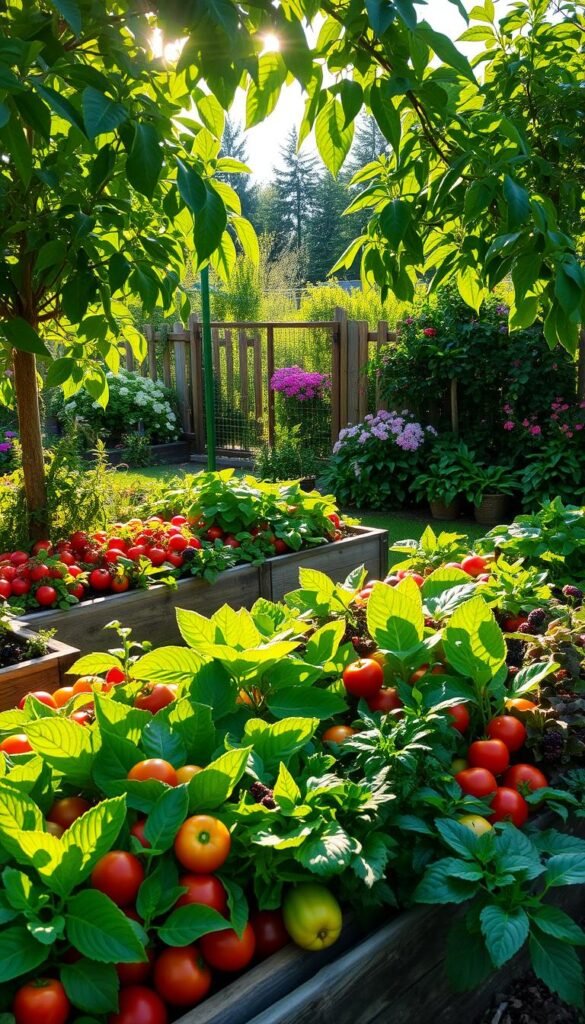There’s nothing quite like stepping outside to harvest ingredients you’ve grown yourself. Whether it’s crisp asparagus in spring or juicy tomatoes in summer, nurturing plants from seed to table brings unmatched joy. A thoughtful layout turns your backyard into a thriving source of fresh meals year-round.
Smart planning starts with knowing how much space you have and what grows best in your area. Pairing compatible crops boosts their growth and flavor—think basil enhancing tomatoes or marigolds protecting squash. Even a modest plot can overflow with bounty when you arrange plants strategically.
Timing matters too. Rotate cool-weather greens with heat-loving peppers to maximize yields. By understanding sunlight patterns and soil needs, you’ll create a resilient ecosystem. This approach reduces pests and ensures every inch works hard for your kitchen.
Your outdoor space can be both practical and inviting. Imagine vibrant greens mixed with pops of color from edible flowers. With careful selection, your harvests will shine in meals while your yard becomes a place of pride. Let’s dive into the essentials for building a productive, beautiful oasis.
Choosing the Perfect Garden Site
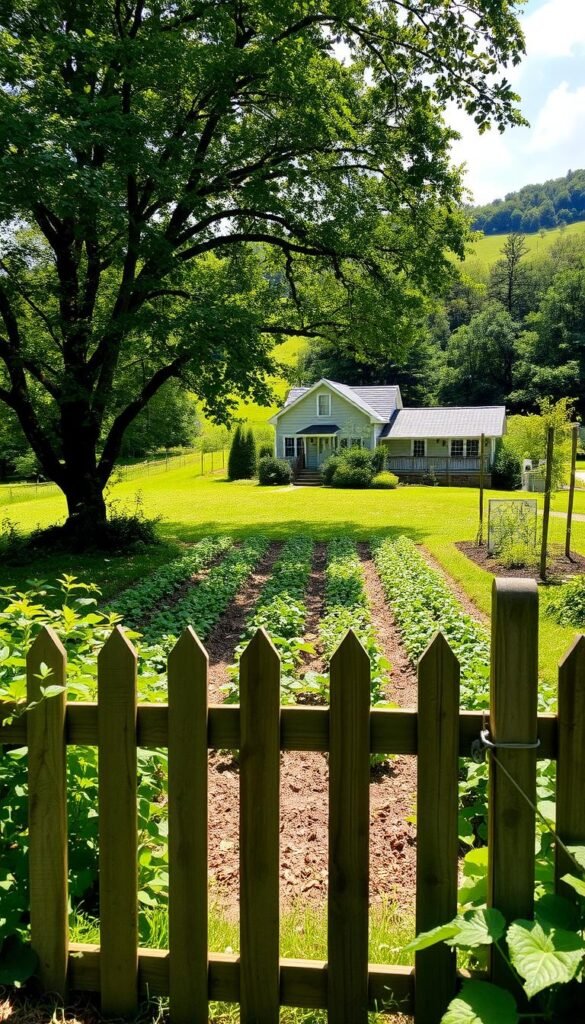
The foundation of every thriving garden lies in its location. You’ll want a spot that balances sunlight, shelter, and convenience. Let’s explore how to match your space with what your plants crave to flourish.
Sunlight, Water, and Soil Essentials
Most vegetables demand 6-8 hours of direct sun daily. Track how light moves across your yard—south and west zones often work best. Test drainage by watering dry soil; if puddles linger after an hour, choose higher ground.
| Factor | Ideal Condition | Quick Fixes |
|---|---|---|
| Sunlight | 6-8 hours daily | Trim overhanging branches |
| Soil Drainage | 1″ water absorption/hour | Add compost to clay soil |
| Soil Quality | Loamy texture | Remove rocks >2″ wide |
Smart Placement Strategies
Position your plot within sight of a frequently used door. This makes it easier to spot thirsty plants or nibbling pests. Keep hoses within 25 feet—nobody enjoys hauling water buckets across a yard.
Steer clear of walnut trees (they release plant-harming toxins) and gusty corners. A fence or shrub row can shield tender seedlings from wind damage. Your perfect garden location balances practicality with growth potential.
Creating Your Garden Vision
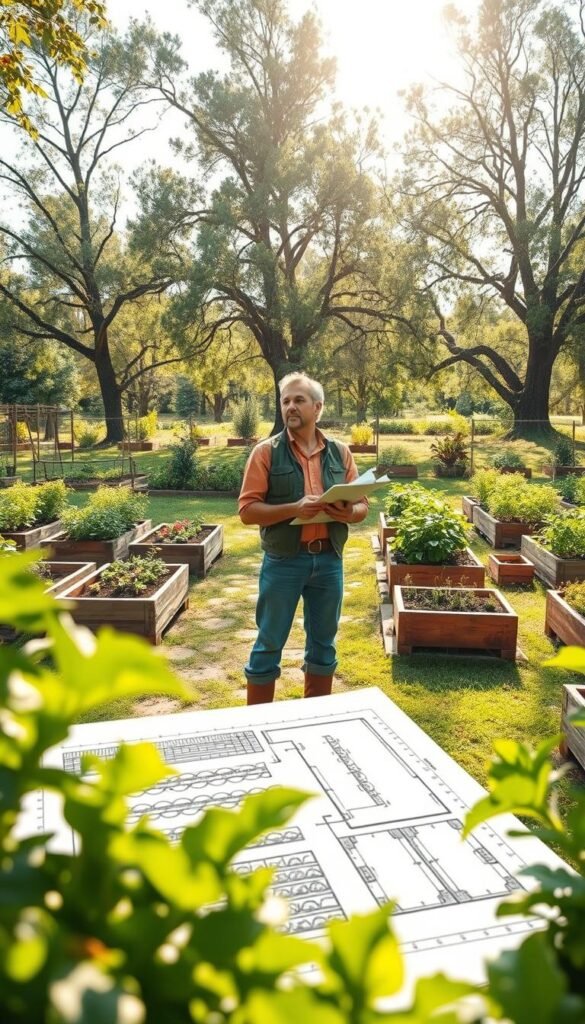
What makes your taste buds dance? Your edible plot should reflect the flavors you crave most. Begin by mapping out which plants will transform ordinary meals into kitchen creations worth celebrating.
Crafting Your Personalized Plant List
Start by jotting down every edible plant that excites your household. Prioritize varieties your family loves—like juicy tomatoes or fragrant basil—over crops that might go unused. Ask yourself: “Does store-bought lettuce satisfy me, or will homegrown leaves taste fresher?”
Vertical structures unlock space for vining vegetables. Cucumbers and pole beans thrive on trellises, freeing ground area for leafy greens. Reserve sunny corners for perennial favorites—asparagus beds or herb plants like rosemary demand permanent homes but reward you annually.
Be honest about quantities. Six zucchini plants might overwhelm a small household, while a single strawberry patch could delight neighbors too. Balance ambition with practicality, leaving room to experiment with new flavors each season.
Your garden becomes an extension of your plate. By focusing on what you truly enjoy, every square foot grows purposefully.
Understanding Soil and Nutrient Needs
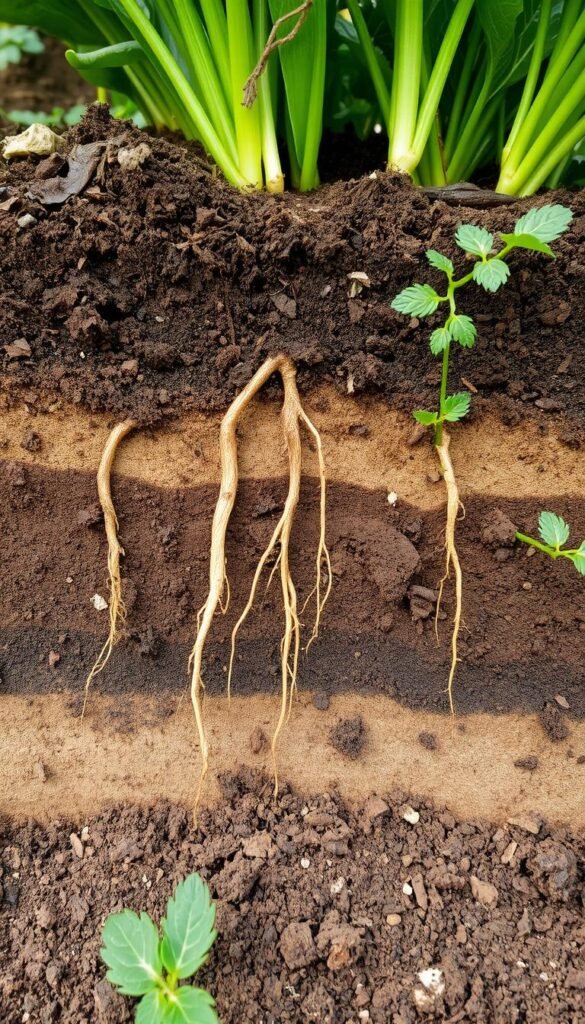
Your garden’s true magic begins beneath the surface. Healthy soil acts like a pantry, storing nutrients that fuel plants from roots to leaves. Without this hidden support system, even the sunniest plot struggles to produce vibrant harvests.
Start by testing your dirt’s pH and mineral levels. Kits from garden stores reveal if your soil needs lime for acidity or sulfur for alkalinity. Tomatoes crave slightly acidic conditions (6.0-6.8 pH), while carrots prefer neutral ground (6.5-7.0).
| Nutrient | Role in Growth | Common Amendments |
|---|---|---|
| Nitrogen | Leaf development | Blood meal, compost |
| Phosphorus | Root formation | Bone meal, rock phosphate |
| Potassium | Disease resistance | Wood ash, kelp meal |
Heavy feeders like corn demand richer soil than radishes or beets. Boost fertility with compost—it improves texture and releases nutrients slowly. Spread 2-3 inches over beds each spring.
Watch for hungry plants. Pale leaves often signal nitrogen lack, while purple stems hint at phosphorus shortage. Pair these observations with companion planting strategies to maximize your garden’s potential.
Remember: thriving roots mean thriving yields. By nurturing your soil, you create a living foundation that supports every bite you’ll harvest.
Planning Your Layout on Paper
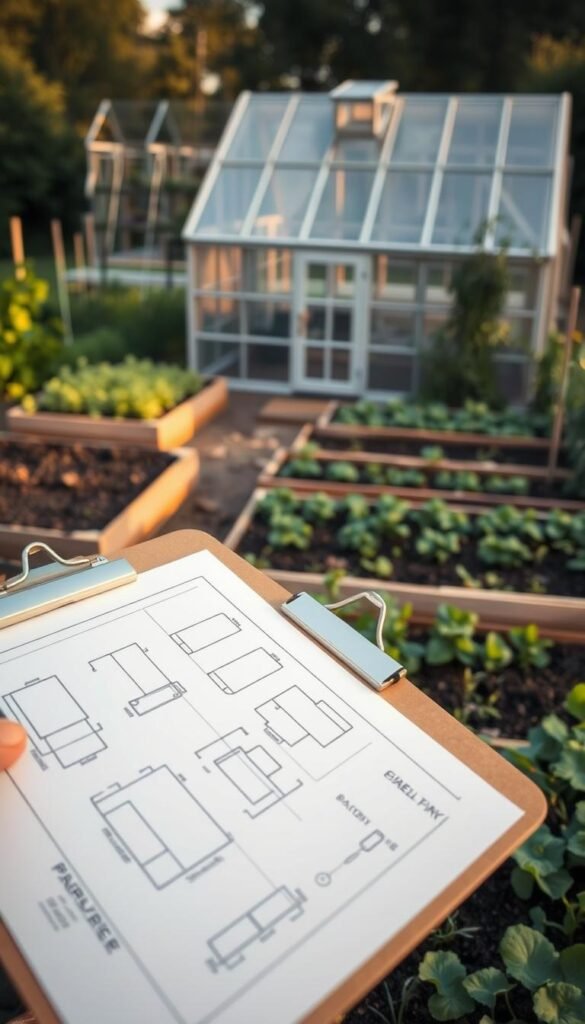
Transforming your garden vision into reality begins with precise mapping. Grab graph paper and a measuring tape—these tools turn guesswork into strategy. Scaling your space at 1 foot per square ensures every plant gets its perfect spot without overcrowding.
Sketching and Measuring Your Garden Area
Start by marking bed boundaries using your measurements. Keep widths under 4 feet—this lets you tend to plants without stepping on soil. Wider paths (at least 2 feet) accommodate wheelbarrows during harvest season.
Note each crop’s mature size. Sprawling squash needs triple the space of compact herbs. Group vegetables with similar sun needs together. Tall corn stalks shouldn’t shade sun-loving peppers nearby.
| Element | Ideal Spec | Common Mistake |
|---|---|---|
| Bed Width | 3-4 ft | 5+ ft (causes soil compaction) |
| Path Width | 24-36 in | 18 in (blocks equipment) |
| Plant Spacing | Per seed packet | Guessing distances |
Update your sketch as you learn. Last year’s tomato spot might rotate to beans this season. Your paper plan evolves with your garden, becoming a living record of growth.
Fruit and Vegetable Garden Design: Coordinating Crops for Flavorful Success

Structure determines success in your edible space. Position tall varieties like pole beans or corn at bed edges to avoid shading sun-loving peppers and leafy greens. Mid-sized plants like eggplants thrive in central rows, while compact herbs claim front-row spots for easy snipping.
Group allies together for mutual benefit. Basil nestled near tomatoes boosts flavor and repels aphids, while radishes deter cucumber beetles when planted with squash. This planting strategy creates natural pest barriers while enhancing growth rates.
Flowers aren’t just decorative—they’re workforce multipliers. Marigolds repel nematodes near tomato roots, while sunflowers lure pollinators to bean blossoms. Intersperse nectar-rich blooms like zinnias every 10 feet to sustain beneficial insects through the growing season.
Rotate vegetables annually to outsmart soil-borne threats. Follow heavy feeders like corn with nitrogen-fixing peas, then nutrient-light carrots. Track placements on a simple sketch to avoid repeating mistakes. Healthy plants start with fresh ground each year.
Your layout evolves as you learn. Maybe next year’s garlic patch replaces this summer’s bush beans. With thoughtful arrangement, every square foot becomes a partner in your garden’s flavorful success.
Innovative Raised Beds and Container Gardening Strategies
Elevate your growing game—literally—with smart gardening solutions that conquer space and soil challenges. Whether you’re working with heavy clay or a tiny balcony, these methods let you customize conditions for thriving plants.
Benefits of Raised Garden Beds
Raised beds give you command over drainage and soil quality. A 4×4-foot box warms faster in spring, letting you plant lettuce weeks earlier than in cold ground. You’ll spend less time bending—most tasks become waist-high chores instead of backbreakers.
| Feature | Raised Bed | In-Ground |
|---|---|---|
| Drainage | Superior | Variable |
| Soil Temp | Warmer earlier | Slower to warm |
| Accessibility | Easier maintenance | More bending |
Struggling with soggy clay? Fill your raised bed with a mix of compost and sand—plants will develop stronger roots without waterlogged conditions. Rotate crops annually to keep soil nutrients balanced.
Container Options for Small Spaces
No yard? No problem. Fabric pots on patios grow crisp peppers, while stacked planters turn walls into vertical herb gardens. Glazed ceramic containers add style to decks while housing compact tomato varieties.
Choose containers twice as wide as mature plants for root space. Self-watering boxes are perfect for busy growers—they maintain consistent moisture between your visits. Mix edible flowers like nasturtiums with greens for beauty and pest control.
With these strategies, you’ll transform tricky spaces into productive havens. Your harvests will flourish where traditional plots can’t compete.
Optimizing Space With Companion Planting
Turn your garden into a teamwork masterpiece where plants work together like best neighbors. Companion planting lets you grow more in less space while creating natural defenses against pests. It’s like hosting a dinner party where guests bring mutually beneficial dishes.
Start by pairing buddies with complementary needs. Basil boosts tomato flavor while repelling flies, and marigolds protect squash roots from nematodes. These partnerships reduce chemical use and make harvests tastier.
| Power Pair | Benefits | Spacing |
|---|---|---|
| Carrots + Onions | Deter each other’s pests | 6″ between rows |
| Cucumbers + Dill | Attract pollinators | 12″ apart |
| Peppers + Oregano | Improve soil nutrients | 8-10″ spacing |
Mix shallow and deep-rooted vegetables to prevent competition. Lettuce grows happily under tomato vines, using different soil layers. Aromatic herbs like thyme make great border guards—their scent confuses pests hunting for kale or cabbage.
Time your planting like a pro. Quick-growing radishes can share space with slowpoke carrots—harvest the radishes before carrots need room. This staggered approach keeps your garden productive all season.
Your plants will thrive when surrounded by supportive friends. With smart pairings, you’ll create a self-regulating ecosystem that yields more with less effort.
Scheduling Your Planting for the Growing Season
Timing transforms good gardens into great harvests. Knowing when to sow seeds separates bumper crops from missed opportunities. Let’s break down how to sync your calendar with nature’s rhythms.
Cool-Weather Champions vs Summer Stars
Leafy greens like spinach thrive when temperatures hover between 50-70°F. These cool-season vegetables bolt once heat arrives, so plant them as soon as soil thaws. Succession planting extends your harvest—sow lettuce every 14 days for nonstop salads.
Warm-season plants demand patience. Tomatoes and peppers sulk if planted before soil hits 60°F. Use this trick: “If you’re comfortable in a T-shirt at night, your seedlings will be too.”
| Crop Type | Soil Temp | First Planting |
|---|---|---|
| Cool-Season | 40°F+ | 4-6 weeks before last frost |
| Warm-Season | 60°F+ | 1-2 weeks after last frost |
Check seed packets for “days to maturity.” Quick growers like radishes (25 days) let you squeeze in extra plantings. Pair them with slower vegetables—harvest radishes just as carrots need more space.
Your local extension office provides frost date maps. Mark these dates prominently—they’re your roadmap for a productive growing season. Staggering plantings ensures fresh picks from spring’s first peas to fall’s final kale.
Managing Watering and Fertilization Practices
Water and nutrients act as your garden’s pulse—keeping everything alive and thriving. Smart hydration starts with knowing your soil type. Sandy dirt drinks faster than clay, demanding more frequent watering sessions. Pair this knowledge with quality products like Miracle-Gro Garden Soil for vegetables to build a resilient foundation.
Tips for Efficient Irrigation
Drip systems deliver moisture straight to roots, cutting waste by 50% compared to sprinklers. New seedlings need gentle daily sprays, while mature plants prefer deep soaks every 3-4 days. Check soil moisture by sticking a finger 2 inches deep—if it’s dry, it’s time to water.
| Method | Best For | Frequency |
|---|---|---|
| Soaker Hose | Row crops | 2 hours weekly |
| Watering Can | Containers | Daily in heat |
| Drip Lines | Fruit bushes | 30 mins daily |
Essential Nutrient Guidelines
Mix compost into beds each spring to feed soil microbes. For potted plants, use Miracle-Gro Potting Mix to prevent compaction. Feed every 4-6 weeks with balanced plant food—yellow leaves often signal nitrogen hunger. Always follow label rates to avoid burning delicate roots.
Watch for curled leaves or standing water—these scream “help!” Adjust your routine after heavy rains or heat waves. With careful attention, your plants will drink deeply and grow boldly.
Adopting Effective Crop Rotation Techniques
Smart crop rotation works like a secret weapon against hidden threats in your beds. By shifting plants to new locations each year, you disrupt pests’ favorite hangouts and starve out disease before it gains ground. Imagine it as a chess game where you control every move.
Group crops by family for maximum impact. Nightshades (tomatoes, peppers) leave behind specific soil challenges—rotate them with nitrogen-fixing peas or beans next season. This swap replenishes nutrients while confusing insects hunting for their usual meals.
| Previous Crop | Ideal Follow-Up | Benefit |
|---|---|---|
| Tomatoes | Bush Beans | Restores nitrogen |
| Cabbage | Sweet Corn | Breaks pest cycles |
| Carrots | Spinach | Uses different nutrients |
Keep a garden journal—sketch bed layouts and note what grew where. “Last summer’s zucchini patch becomes this spring’s lettuce haven,” you’ll remind yourself. These records prevent repeat performances by disease agents lurking in the dirt.
Between growing seasons, plant fast-growing clover or rye. These cover crops suppress weeds while adding organic matter when turned under. Your soil stays lively and ready for next year’s lineup.
“Rotating strategically lets your garden heal itself while you reap healthier harvests.”
Learning from Past Garden Experiences
Every season in the dirt teaches something new—if you’re listening. Track patterns in your harvests to spot what thrives and what barely survives. Did aphids swarm your kale? Maybe nasturtiums need planting nearby next spring. These observations become your secret growth formula.
Celebrate Wins, Adjust Challenges
Jot down bumper crops in a journal—those juicy tomatoes loved afternoon shade. Sketch bed layouts that maximized yields. Apps like Gardenize help digitize notes for quick reference next planting time.
Struggles hold equal value. If squash vines overwhelmed paths, allocate more vertical space. Yellowing leaves might mean adjusting soil pH or watering habits. Each “oops” moment guides smarter choices.
Experiment With Confidence
Next year, try one new technique—maybe interplanting flowers with herbs. Track results against previous methods. Nature rewards curiosity; even small tweaks can boost plant health dramatically.
Your evolving knowledge turns setbacks into stepping stones. With each season, you’ll cultivate not just food, but wisdom that blossoms year after year.

